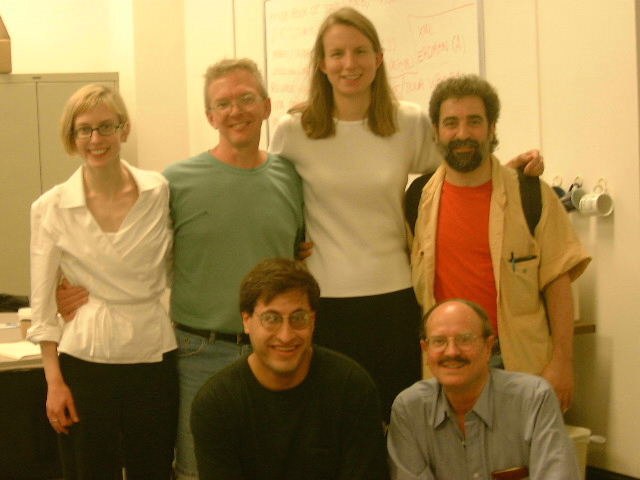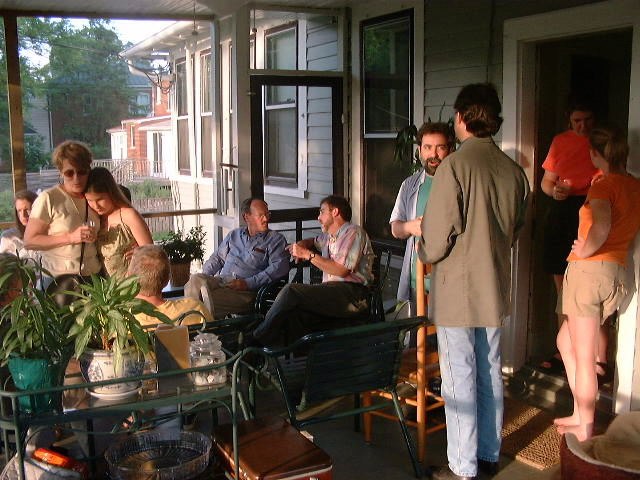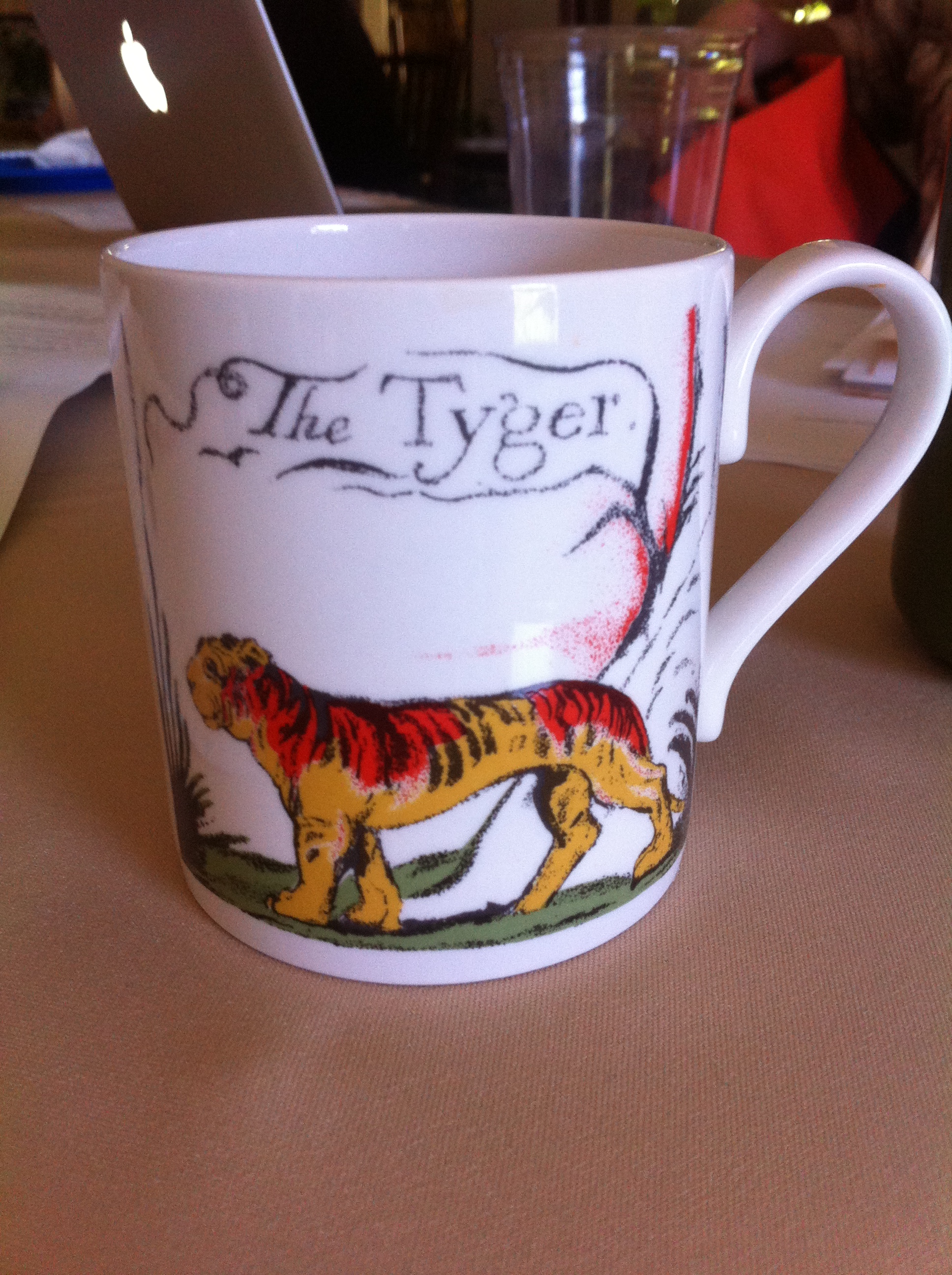“Blake Boyz” and “Blake Camp” are sticky labels that John Unsworth invented in the early years of the Archive. This June Blake Camp celebrated its 21st birthday—or maybe its 19th or 20th, depending on how you count, because the label came a bit later than the annual gathering of the principal participants.
To understand what Blake Camp—the annual pivot point for our project—is and how it got that way, a little history is helpful.

Blake Camp participants back in 1999.
Back row from the left: Kari Kraus, Morris Eaves, Andrea Laue, Joseph Viscomi. Front row from the left: Matt Kirschenbaum, Robert Essick.
Photo by John Unsworth
In the December 1997 issue of the online Journal of Electronic Publishing appeared “Behind the Scenes at the William Blake Archive: Collaboration Takes More Than E-mail,” [DOI: http://dx.doi.org/10.3998/3336451.0003.202] a slightly expanded version of a paper I had presented in September at Unsworth’s session of DRH97, a conference on digital resources in the humanities at St. Anne’s College, Oxford. I began by explaining that my presentation
concerns the William Blake Archive, a Web-based project supported by the Getty Grant Program and developed under the auspices of the Institute for Advanced Technology in the Humanities at the University of Virginia. . . . My collaborators [Robert N. Essick and Joseph Viscomi] and I have just passed the two-year point of what began as a three-year project—not a bad time to take an honest look back at our original vision of collaboration and measure it against the gritty street-level realities we’ve encountered. At this point we have chalked up a string of accomplishments that we think we’re justified in feeling fine about — we may be a tiny bit infected still with techno-optimism. But getting here has chastened us, put our communication skills if not our friendship to the test, lowered our sights, and given new meaning to and new appreciation for “cooperation” and “compromise.” The narrative of those alterations and the useful lessons we may have learned so far are the subject of this article.
John Unsworth’s directive for the session at which this paper was first presented went like this: “The topic is collaboration in the production of digital resources. You’re doing it in a way, and on a scale, that very few people in the humanities have done: Whatever seems most notable about that experience, that’s what you should talk about.”
That could be flattering, but when I heard it what stood out in my mind was a two-line e-mail message I got from my most technology-averse collaborator, Bob, a couple of weeks ago: “Morris—I can’t read e-mail any more. Please send hard copies. Bob [Essick].” Bob soon lifted his e-mail ban, but that should undercut unintentional utopian overtones while I do a quick sketch of a many-handed undertaking now going into its third year.
. . . .
Any account of our collaboration does, after all, have to include the thing we collaborate over, the Archive itself. The first two years were devoted mainly to research and development. By the end of the first year there was a public Blake Archive site that was handsome, but thin compared to what we were aiming for. All the real action was behind the scenes at our private, password-protected, work-in-progress site. . . . I promised earlier to come back to the place of face-to-face in our scheme. It would be less true to say that we gave it a place than that it earned its place. The actual, like the virtual, is not good for everything; surrogates like e-mail are in many cases preferable: more efficient, more forgiving, less fraught. But we have found that, as a court of last resort, there is no virtual stand-in for meeting in person. Hence the annual institution we have come to call Blake Camp, which at first was a planning session but has become a problem-solving, assessing, and planning session that happens every summer in Charlottesville. The Blake Boyz, as John calls us, fly in for these annual summer get-togethers—even Bob, who hates travel the most. This summer’s Blake Camp took up three solid days in June. The centerpiece was a roundtable gathering in the central office at the Institute. All the usual suspects were there, either participating or on call in their offices nearby. The Blake Archive was projected on the screen in front of us from 9 till 5 as we worked our way through a tricky and tedious agenda.
This summer’s session [1997] came at the climax of a long series of tests that had led to some testy exchanges on blake-proj and marathon telephone conversations that hadn’t clarified much. The goal was to publish, no later than this summer, the first fully enriched illuminated book, adorned with all our clever bells and whistles. When that had happened, we said, then and only then could we move from our research-and-development stage to a new and presumably much smoother and easier production phase where the main work would go into publishing all the works that had been piling up in the background while development and testing had taken over the foreground.
All the most important pieces had been in place for months. We knew pretty much what a page would look like, what you could do with the texts and images, and what tools you needed to do it with—all now diagrammed and labeled in the clever help-document graphics devised by our current project manager, Matt Kirschenbaum. We had settled on one short illuminated book, Blake’s eight-plate Book of Thel, copy F, from the Library of Congress’s extensive Lessing J. Rosenwald collection, as our guinea pig. Thel had been scanned, color corrected, and transcribed. You could enlarge the images, read the text right on the plates or in more readable transcriptions, search for texts, search for images, read descriptions of every image or part thereof, among other things.
But no sooner would John post a proud message to blake-proj proclaiming the latest programming victory over some stubborn problem than Bob, Joe, or I would post a counter-note saying that the thing wasn’t doing what we wanted it
to do at all. The three of us were approaching terminal frustration with search formulas that couldn’t produce the right hits on the right things and unstable bumper-car Java applications that looked cool as hell but cluttered the screen with annotations that didn’t match the picture-details being annotated. I’m sure the programmers were totally exasperated with what must have seemed to them an interminable list of demands from us contradicted by double messages. They were understandably pleased with the miles they had brought us; we were frustrated with the miles that hadn’t been crossed. The atmosphere was charged.
It took Blake Camp to begin turning what was starting to feel like defeat—the three of us were talking among ourselves about how to lower our sights and cut our losses—into what felt like a chance at victory. But as we talked through the problems one by one with the Archive right in front of us all, with everyone who was relevant to a solution there to contribute, we discovered that many of the smallest problems could be dealt with on the spot, with John pounding the keyboard to change the SGML or the search logic or the format of a button as we exposed the source of one misunderstanding after another. Several larger problems would take longer. But along the way we regained our optimism and our confidence, I think largely because we realized that we had managed to come back to a common understanding of what we were after and what could be achieved.
When I look back I can see that the trick was in knowing when that common understanding had really emerged. In key instances it turned out that what we all thought was a common understanding wasn’t intact. The shell of the understanding was full of lethal little leaks. Along the path of collaboration subtle cracks had opened in our e-mail communications, and in them misapprehensions had sprouted. This is hard to describe. I felt it in audiovisual terms as a combination of noise in the system and invisible gaps. And the cure was all too familiar: lengthy face-to-face hashing-it-out that puts us over and outside the more routine information channels that we had usually been inside. The medium of those channels had blurred the message just enough to seduce senders and receivers into an illusion of understanding.
After two of the three days of Blake Camp the air began to clear. The third day felt almost restful. On August 4 [1997] we issued this announcement:
The editors of the William Blake Archive—Morris Eaves, Robert Essick, and Joseph Viscomi—are pleased to announce that The Book of Thel, copy F, is now online in searchable form. This may seem a modest achievement, given that this is one of Blake’s shorter works, and that its eight plates (with enlargements and accompanying transcriptions) have already been available on the site since November of 1996. In fact, however, this copy of The Book of Thel is a prototype for all future works to be added to the Archive (both illuminated books and other materials), and its appearance reflects the architecture and objectives of the Archive as they have taken shape over many months of development, testing, and refinement.
Unlike its previous version, and unlike the other illuminated books currently available in the Archive, this copy of Thel has been tagged using SGML (Standard Generalized Markup Language). SGML tagging offers the Archive’s users the opportunity to perform sophisticated searches, either on the text of the plates, or, more remarkably, on the content of their illustrations. Search results are retrieved and presented using DynaWeb, a product of the Inso Corporation. The text and image searching enabled by DynaWeb and the underlying SGML tagging is a powerful demonstration of the potential of electronic resources in the humanities.
However, there’s more. Users with Java-capable browsers can now make use of Inote, Java-based software developed at the Institute for Advanced Technology in the Humanities, to assist them in their study of the Archive’s visual materials. Users may employ Inote to examine editorial annotations of a given image independently of a search, or else, following a successful image search, Inote may be used to open the image, zoomed to the specific area containing the object of the search, together with the relevant editorial commentary. This is IATH’s first public implementation of Inote, and its release marks a major advance for image-based electronic editing.
Users with Java-capable browsers can also take advantage of a second, equally innovative Java program developed at IATH, the ImageSizer. This is a feature that allows one to view Blake’s plates and images at their true size, reproducing the object’s actual physical dimensions on the screen, regardless of the resolution of a particular monitor; indeed, users can calibrate this feature to consistently display the Archive’s images at whatever proportions they may wish.
Finally, the Archive’s selective bibliography of criticism, reference materials, and standard editions, with about 500 entries, is now available. We hope to have the bibliography searchable by the end of the summer. We also hope to have David V. Erdman’s Complete Poetry and Prose of William Blake online and searchable by that same time.
In the coming weeks and months we will turn our attention to placing other illuminated books online in searchable form, following on the model of The Book of Thel, copy F. We will begin with the other copies of Thel (copies H and O), as well as copies of Visions of the Daughters of Albion (copies C and J) now publicly available only in HTML—thus lacking any of the capabilities described above. We will then move on to other books: All Religions are One (copy A), There is No Natural Religion (copies C and L), The Marriage of Heaven and Hell (copy D), America (copy E), Europe (copies B and E), The Song of Los (copies A and B), The Book of Urizen (copy G), Songs of Innocence and of Experience (copy Z), The Book of Ahania (copy A), and The Book of Los (copy A).
Enough, Blake writes, or Too Much! But there they are—the abiding reasons for Blake Camp. After we skipped the summer of 2006 during a major transition from the old SGML architecture to our current standard, XML, in 2007 Blake Camp moved with the Archive from the University of Virginia in Charlottesville to the University of North Carolina in Chapel Hill. In 2007 our scope broadened to include the work of a new team at the University of Rochester, and in 2012 Mark Crosby, from Kansas State University, began attending Blake Camp as our first official bibliographer. In 2012 sessions were shortened from three days to two. In 2013 we met at Bob Essick’s house in Altadena, California. No matter where or when, Blake Camp has never been less than indispensable. The sessions are now more compact and the rhetoric more subdued (though a novice might be surprised to hear that), but old questions haunt our deliberations, and new issues that we could never have predicted arise almost every year.
Next: Highlights of Blake Camp 21, 2014
—


